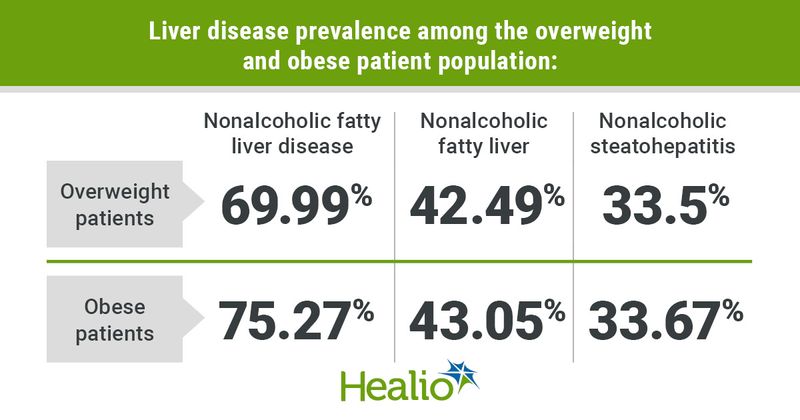Risk stratification may improve NAFLD intervention in obese, overweight populations
Click Here to Manage Email Alerts
Results from a meta-analysis underscored the need to improve understanding of nonalcoholic fatty liver disease burden and management in at-risk individuals who are overweight and obese.
“According to the latest guidelines from the American Association of Clinical Endocrinology, overweight and obesity status is an effective risk factor for first-line NAFLD screening at the primary care level,” Jingxuan Quek, MBBS, of the Yong Loo Lin School of Medicine at the National University of Singapore, and colleagues wrote in The Lancet Gastroenterology and Hepatology. “However, the global prevalence of NAFLD in the overweight and obese population remains unknown.”

In a systematic review and meta-analysis, Quek and colleagues analyzed 151 studies to determine the global prevalence of NAFLD, nonalcoholic fatty liver (NAFL) and nonalcoholic steatohepatitis among those classified as either overweight or obese. Additional analyses evaluated the prevalence of fibrosis in those with NAFLD.
Of 101,028 individuals included in the pooled analysis, the prevalence of NAFLD in the overweight population was 69.99% (95% CI, 65.4-74.21), the prevalence of NAFL was 42.49% (95% CI, 32.55-53.08) and the prevalence of NASH was 33.5% (95% CI, 28.38-39.04), with the highest NAFLD prevalence reported in the Americas (75.34%; 95% CI, 67.31-81.93).
Among those in the obese population, the prevalence of NAFLD, NAFL and NASH was 75.27% (95% CI, 70.9-79.18), 43.05% (95% CI, 32.78-53.97) and 33.67% (95% CI, 28.45-39.31), respectively.
Further, clinically significant fibrosis (stage 2-4) was identified in 20.27% (95% CI, 11.32-33.62) of overweight individuals with NAFLD and in 21.6% (95% CI, 11.47-36.92) of obese individuals with NAFLD. Advanced fibrosis (stage 3-4) was present in 6.65% (95% CI, 4.35-10.01) and 6.85% (95% CI, 3.85-11.9), respectively.
“Obesity is a well-known risk factor associated with NAFLD,” Quek and colleagues concluded, “and these findings could be pivotal in improving the stratification of the disease burden for future early clinical intervention in overweight and obese individuals, especially at the level of primary care.”
